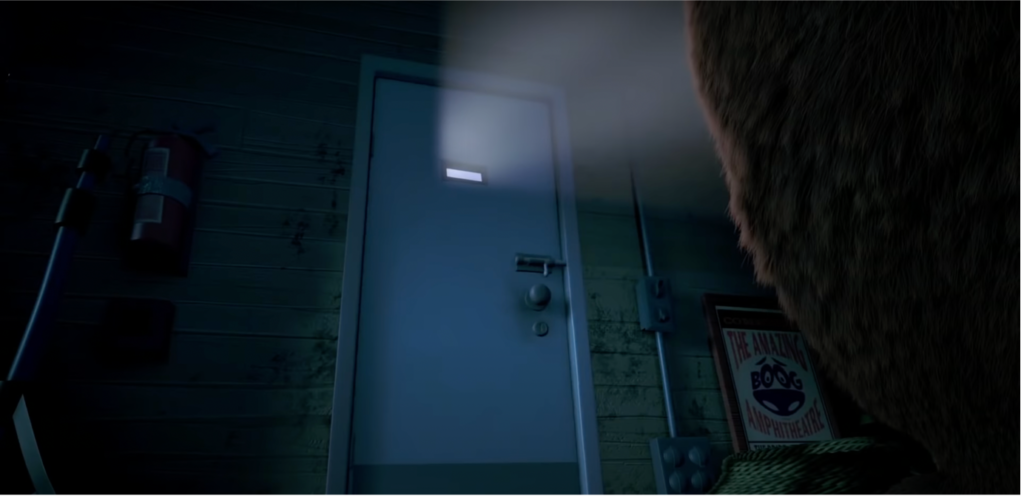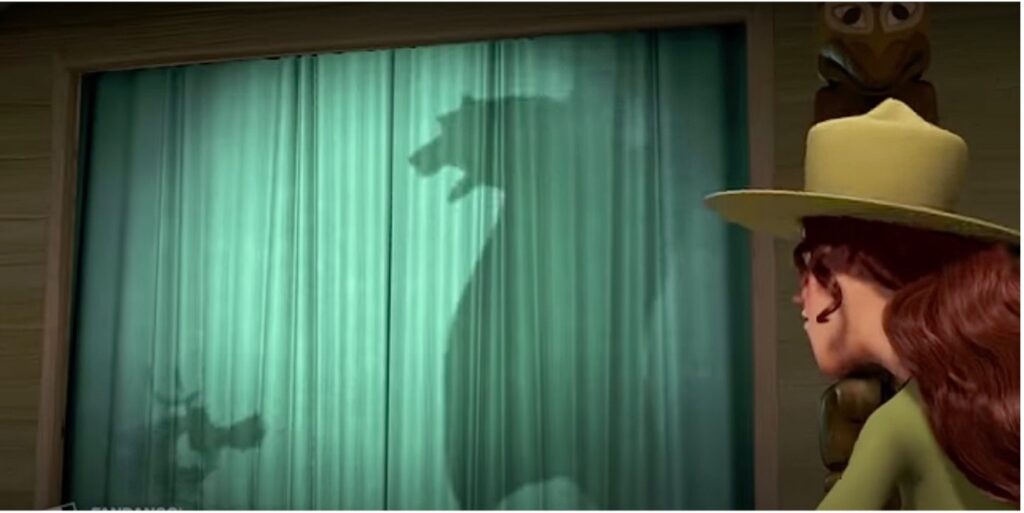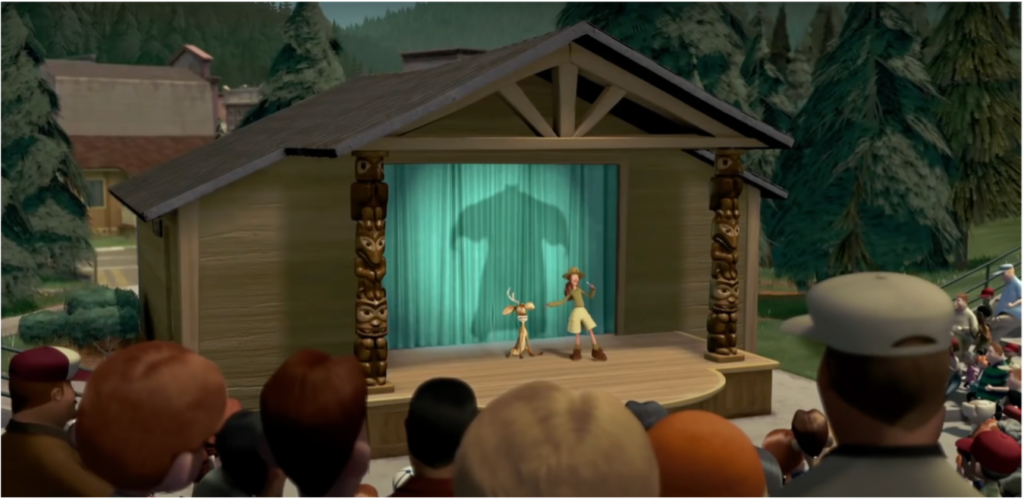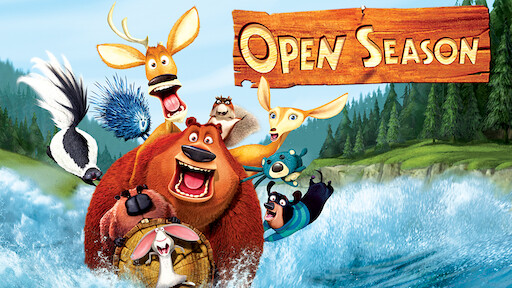Staging an Attack
Open Season (2006) uses light composition and visual design to critique dominant ideologies concerning hunter-and-hunted relationships and to reflect and shape particular cultural tensions relating to the protection of animals against violence.

In a scene in which, misconceptions lead to a crowd panicking when it appears Boog is killing Elliot backstage, emphasis is placed on the use of lighting, particularly shadows. The only light present is filtered through a tiny window on the door (see Figure 2). Light plays a significant part in revealing the truth and having it filtered through a small gap prevents a full picture from being portrayed.

Most of the scene takes place literally behind the stage curtain in darkness (see Figure 3), Boog and Elliot’s actions are concealed and thus misconstrued which inevitably escalates the situation. This leaves the audience to interpret based on their prejudices of wild animals, particularly predator and prey relationships.

Boog and Elliot’s relationship is depicted through shadows (see Figure 4), adding a suspenseful layer of uncertainty to their interaction. Shadows lack the detail needed to distinguish features, and how situations are perceived and thus a false reality is constructed. This alludes to Boog’s delusion in believing he can remain domesticated in a human environment, as seen through adopting the persona of a performing animal on stage, appealing to human audiences instead of satisfying his wild and innate instincts as a bear. He finds too much comfort in his civilised anthropomorphic life to the extent he becomes deluded into thinking he is being perceived and treated as humans equal. When things inevitably fall apart (see Figure 1) when interacting and challenging tensions/ relationships between a performing animal and a wild animal [Elliot] he is distraught and betrayed at the reaction he endures from a human audience that perceives him only as dispensable entertainment. As a performing animal, he is naive in thinking his whole persona is not a performance. It is an act to conceal the untamed version of him within, igniting the conflict of domesticated-to-wild that many animals endure when wrongfully kept as pets and urging us to question the ethics surrounding the pet-keeping of exotic animals.
Ancient symbolism believes shadows embody the dark side of nature, portraying Boog as the innately wild predator bears are. The audience received a show but not one they expected, demonstrating the unpredictability of wild animals and how domesticating them against their nature only puts them at risk when they inevitably return to an environment they have not habituated to. The film narrative sets up this major conceptual opposition. Paul Wells discusses this within his concept of ‘The Madagascar Problem’ (Paul Wells, The Animated Bestiary) and his blurring of wild/civilised opposition and free/captive opposition. Boog is evidently caught between anthropomorphism and animalisation representations leading to his moral dilemma and identity crisis. He is in denial and unable to accept his roots as he craves social desires and class characteristics he will never achieve as they are not associated with or expected of wild animals. This ludicrously of Boog wanting to be human with human characteristics and values creates the comedic element in Open Season.
Once these oppositions are disrupted by the arrival of Elliot, tensions between the two species are difficult to resolve resulting in the catastrophic interaction (see Figures 1,2,3,4) and the eventual exile of Boog into the wilderness which he struggles to navigate.
Boog is depicted towering above Elliot (see Figure 4), the lighting scheme shaping our perception of him as higher in the animal kingdom and food chain, immediately establishing Elliot as prey and Boog as predator. However, having him shadowed emphasises the falsity of this portrayal as behind closed curtains an ironic friendship is formed against nature, representing the values of friendship, loyalty, and respect that humans should similarly share.
Open Season (2006) depicts human-animal relationships in a comedic way while allowing an informative insight into the inter-social relations between species and our relationships as humans with other creatures regarding hunting and pet-keeping. Camera angles and lighting helps to shape our view of the characters and their spaces providing a nuanced understanding of them and their place in the world. Shadowing and its obscurity allow for prejudices, regarding wild animals, to fill in the blanks hence the altercation between Boog and Elliot being misconceived and escalated so dramatically as a performance of predator-prey savagery.
The film addresses several important issues surrounding our treatment of animals, ultimately suggesting we should learn from how animals interact with each other and are more mindful of how we treat them and the natural order. Humans in the film are careless in taming animals and cruel in hunting them, juxtaposed with the animal’s caring and cooperative nature when later banding together to fight human corruption and take back the forest into nature’s control.
Bibliography
Open Season (2006) Directed by Allers, Roger. Available at: Box of Broadcasts (Accessed: 12 November 2022)
Kimberlee Gillis-Bridges, English 345: American Independent Film, Questions for Film Analysis, <http://faculty.washington.edu/kgb/independent/handouts/film_questions.pdf > [accessed 13 November 2022]
Paul Wells, The Animated Bestiary
Film details:
Title:
Open Season
Year of Release:
2006
Director:
Roger Aller’s
Country of Production:
United States of America
Distributor:
Sony Pictures Animation, Columbia Pictures
Does the film contain Imaginary Animals?
No
Language:
English
Kind of Animal(s):
Bear, Deer, Stag
Types of Human-animal relations:
Petkeeping, predator-prey, Hunting/Trapping, Animal Protection
Relevant major genres:
Adventure, Comedy
Relevant subgenres:
Children’s, Family
Formats:
Animation
